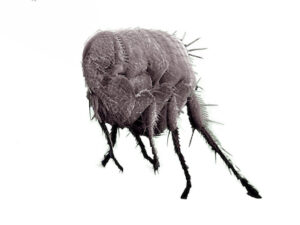Understanding How Fleas Get in The House
We all know fleas can travel into your home via a cat or dog. If you’ve ever had a pet, you may have noticed your pet scratching or even seen a few creepy, crawly fleas hopping around your home. But if you don’t have a pet, how can fleas get in the house? You can keep your home super clean, but fleas can sometimes be a problem. Even if you have the cleanest, pet-free home, you still may have to deal with fleas infesting your house.
But, how do fleas get in the house without pets? Fleas normally enter your home through a host. Usually, it is a dog or cat that has been outside and attracted fleas. They don’t always come through pets though. Fleas live outside and hang out in grass, woods and fields. Visiting animals to your yard such as skunks, rabbits, feral cats, squirrels, opossums and even bats may be bringing fleas to your yard. Rats and mice infested with fleas may be entering your home.
9 Ways that Fleas can get in Your House without Pets
- You bring them in on your clothes
- An old piece of furniture
- Cracks in your floors or around windows
- Under doors
- Mice or other rodents in your house
- Visiting animals in your yard like rabbits and squirrels
- Thrift clothes or hand-me downs
- Visiting pets
- Rugs or carpets
Typically, flea infestations can also happen when a home hasn’t been occupied in a long time, and the owners finally return home. Or when new owners take on a home that hasn’t been used in a while. Fleas can lie dormant for a long time and be awaken from their slumber by vibrations or a new host to feed on. You could even have a dirty neighbor with fleas that could come over to your home! In this post, we will discuss several other ways fleas may enter your home with pets as well as ways to treat this annoying problem.
How Fleas Enter Your Home
In addition to the possibilities mentioned above, there are several other ways fleas may enter your home with pets. Oftentimes, fleas can come in through old clothing or an old piece of furniture you have brought into your home. Fleas are microscopic and don’t necessarily need hosts to enter our homes. They can enter a home through cracks in the floor and window screens – even under the door. Vacuuming and cleaning your home, as well as washing your pet and its bedding often is the best way to prevent an infestation of fleas.
Fleas can also be coming into your house by hitching a ride on you or your clothing when you are outside. They don’t normally choose humans as a host, but it’s not uncommon for them to catch a free trip to your home through your shoes or pants after you have been outside. Here are some great tips for identifying fleas in your home.

Why Fleas Attach to a Host
These parasites are well-adapted at finding ways to attach to potential hosts in order to find their next blood meal, the more visitors (human and animal) you have to your yard, the greater the chance of an infestation arriving on the back of another animal. They will snack on the blood of its host. Fleas will find the furriest spots in the deepest crevices of an animal’s (wild or domestic) skin. Often in the neck fur, in the abdomen and in the leg crevices.
Fleas can spread to different rooms and apartments through flea-infested animal nests in a nook or cranny of a building. Then flea eggs can lie dormant in a carpet for months until a potential meal walks by and disturbs them. Vibrations can cause flea eggs to hatch in seconds.
Fleas are nasty little bloodsuckers and thirst for blood as their diet. The females need to be fed to lay eggs. If they don’t have blood in two to five days, the females (and their possible eggs) can die. Keeping them away from their blood source is the best way to prevent their spread. Most fleas can only survive two months without eating.
Signs of Flea Bites
Even if you have the cleanest home, you still may have to deal with fleas infesting your home. You may notice some itchy bites, too. Flea bites usually are found on the feet and ankles. The bites commonly go unnoticed when they happen, but people can experience itching, a rash, and/or irritation after the fact. If the symptoms are bothersome, flea bites can be treated with carbonated petroleum jelly, menthol, ice or calamine lotion.
Fleas can lay eggs your furniture and bedding. These eggs will fall onto the floor and the furniture and spread like wildfire. In just a couple of months, fleas can lay about 500 eggs! In the first two weeks, many of these hatchlings are mostly hidden. They are tiny larvae that fit in tiny floor cracks, carpets, and furniture.
Flea larvae may only take about one to two weeks before maturing; however, with humid and heat weather conditions, it can take up to six months for this larval stage. From there, these larvae will be in insecticide-resistant cocoons for about five weeks. But it’s also possible for larvae to hang inside of their cocoons for a long time until they sense a potential host come by
How Long Do Fleas Live in Your House?
Doing a DIY flea treatment can often help with killing off these pests. However, you still may notice fleas after the treatment is complete. This doesn’t mean that the treatment didn’t work. The remaining fleas can be a result of newly-hatched adults that were inside of a cocoon when you first did the treatment. You can continue to perform the treatment and also wash and vacuum these areas to get rid of them. But if you don’t see it improving in a month’s time you should call a pest control professional.
How Can You Stop Fleas from Entering Your Home?
Keeping your home neat and tidy is the number one way to stop fleas from getting into your house. If you buy second-hand rugs or furniture, be sure to vacuum them off as soon as they enter your home. Always check the secret hiding places of fleas. They love humid and cool areas, so anywhere that doesn’t get much sun is a good place to start.
Keep your yard trimmed and as free of weeds as possible. Seal obvious nooks and crannies with sealant foam to keep both fleas, as well as flea-carrying rats and mice out of your home. Thoroughly clean, scrub, and vacuum anywhere you fear they might be hiding. Always throw anything machine washable into the washing machine if you fear they have been compromised. Cushions, sheets, and throw rugs are all susceptible to flea infestation. You should aggressively vacuum and clean all of the carpets and furnishings.
Preparing for Professional Flea Treatment
Sometimes, a DIY flea treatment won’t effectively treat and prevent fleas from running havoc in your home. When it’s time to call in a professional, they will ask you to do a few things to prepare your home for treatment.
Everything from the floors should be removed (toys, clothes, etc.). Any bedding should be washed or replaced. You will need to vacuum all of your carpets and rugs, including beneath beds and other furniture. Upholstered furniture should also be vacuumed. All of the floors should be thoroughly swept and mopped. If you have concrete floors in the garage, basement or patio, be sure to clean any area pets may rest with soap and water.
If you have pets like reptiles and birds, they will also need to be removed. Fish tanks should be covered with a damp towel and the air pump turned off. (Note: If you have a saltwater tank, the pumps cannot be disconnected.) Please ensure that crawl spaces are available for the professional to treat, as well.
Many homeowners wonder if they will need to leave the home during a pest control visit. This will depend largely on the type of service you are receiving.
Flea Extermination Process
For most flea treatments, the professional will request that you vacate the premises for a few hours. They will then apply a residual flea control product. The active ingredients have two long-acting components to help to control fleas and break the reproductive life cycle. Adulticide is used to kill adult fleas and developing fleas in the larval stage on contact. An insect growth regulator affects developing fleas. The reproductive life cycle will be interrupted, because any larval stages of fleas that come into contact with the growth regulator will be unable to develop into an adult.
You can expect an immediate reduction in the number of adult fleas in your home after a professional flea treatment. It can be common to see more fleas within seven to fourteen days following the treatment. They are pre-adult (pupal) fleas that were in the pupal stage of development during the treatment. They had not yet come into direct contact with the adulticide used to control them. The residual insecticide does the trick in this case, killing them withing a few hours of contact.
It’s important to also get the areas outside of the home treated, as those are the places the fleas came from in the first place. A professional will treat shades areas and beneath shrubs and decks. Special attention should be given to anywhere that pets rest or sleep.
Preventing Further Flea Infestation
Post-treatment care should include daily vacuuming to eliminate any individual fleas that may surface after the pest professional leaves. Sometimes a second treatment is necessary to ensure all of the fleas have been eradicated. If you have pets, you may need to take additional steps to get rid of dog fleas. With the help of these tips, we hope you can quickly enjoy a pest-free home!
Find more pest control tips from experts here.

